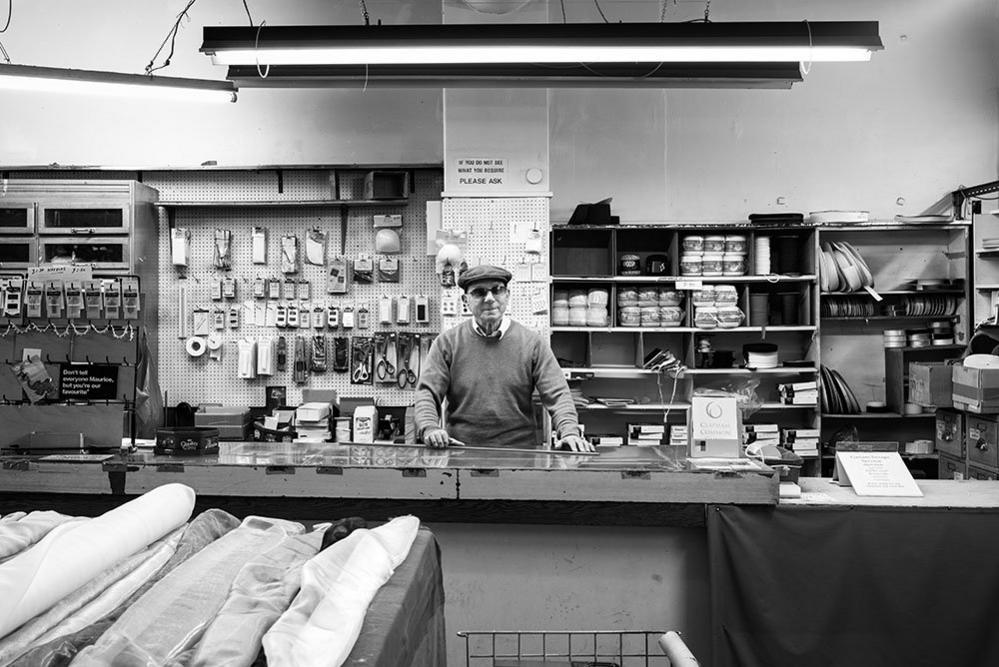In pictures: Behind the shop facade
- Published

Maurice Dorfman ran Jeannette Fashions, a traditional haberdashery shop and the longest-surviving independent shop on Clapham High Street, south London.
His death, in February last year, aged 87, brought to an end a remarkable 60 years of family trading in the heart of Clapham.
And for the past 18 months, Clapham photographer Jim Grover has been piecing together Dorfman's life.
"More than 60 people have shared their stories, old photographs, and mementoes with me, such is the breadth and depth of affection for Maurice in the local community and the desire to help me create a fitting tribute," Grover says.
"He was still opening his shop, every day, in his 80s."
Dorfman's parents came from Jewish tailoring families - and in the late 1950s, the family moved into 20-22 Clapham High Street, an enormous four-storey building, five windows wide, with two shopfronts.
In the "swinging 60s", the first two floors were a dressmaking factory.
Dorfman delivered the dresses to London's fashion shops.
And the family lived above the business.
Grover photographed the objects and pictures he found on fabrics from Dorfman's shop.
And among the many items restored especially for the exhibition is an early 1960s Kodachrome slide showing Dorfman and his mother, Jeanette, with their Harley-Davidson motorbikes.
"This tribute to Maurice is also a piece of social history, bringing back memories of some of the popular pleasures of the 1960s such as motorcycling rallies, ballroom dancing, camping holidays, and sailing, all of which were a big part of Maurice's life," Grover says.
The death of his mother, in 1982, made Dorfman give up his job, as a cutter in the West End, and return to run the family business, which had been turned into Jeannette Fashions.
Catering to the needs of the numerous local seamstresses, costumiers, knitters, crocheteers and dressmakers, it thrived.
And some of Dorfman's customers from the 1980s still have their dress patterns.
"I had every type of fabric you could want," he told Grover, in 2016, "silksā¦ satinsā¦ jacquardsā¦ wedding-dress fabricsā¦ everything... anything.
"People used to buy the patterns and then they'd buy the fabric.
"I used to have to chain the pattern books to the table because people used to pinch the bloody books."
In the 60s, Dorfman's girlfriend was Margaret (pictured above, on the left), originally a dressmaker and seamstress, whom he met at a ballroom-dancing lesson in a small studio on the High Street.
And as part of this project, Grover tracked down her daughter, Anne (on the right), a successful wedding photographer, in the US.
"He was so kind," she said, "he included me in everything.
"When he took her to the theatre and romantic dinners I went too - my poor mother."
One of the many dog owners who made regular visits to Dorfman's shop told Grover: "He absolutely loved my dog and vice versa.
"I couldn't actually walk past the shop if I had the dog without being dragged in for a biscuit.
"He always had a biscuit for my dog and a sweetie for my son."
Following the death of his father, in 1992, Dorfman lived a modest life, alone for 30 years in the enormous flat above the shop, with few of the conveniences of modern life, such as central heating.
"His home is a beautiful time capsule from a bygone era," Grover says.
From the windows of his flat, Dorfman witnessed the profound changes to the High Street over six decades.
The photographs above show the junction with Aristotle Road, in the 1960s and this year.
Many contributors mentioned Dorfman's generosity and kindnesses in the local community - but reciprocal offers of help and support as he grew older were frustratingly rebuffed.
One customer made him a pair of fingerless mittens with the green wool that he stocked and remembers Dorfman asking what he was supposed to do with them.
Although after a while, he came to admit they were "actually pretty good".
Two bouts of cancer, his advancing age and the general challenges facing independent High Street shops gradually took their toll.
The annual rates bill alone exceeded the shop's sales, in its final years.
It was no longer a commercial enterprise - but Dorfman continued to open up every day, giving purpose to his life.
Stock levels dwindled and the shop became a pale shadow of its glory years.
"It was a bit run-down but it looked colourful and it looked exciting and you could go in there and you could feel comfortable," one of Dorfman's customers of many years said.
"The shop had a wonderful homemade feel to all of the various fittings," Grover says.
"I had never noticed the handmade clapper on the ceiling above his cutting room table - but someone who once worked there, back in the 1980s, told me that if the shop got busy, then Maurice would pull the cord which would bang the ceiling, summoning help from the home upstairs."
After Dorfman died, Grover filled the shop window with portraits of him - as a tribute and to communicate his death to the community.
"The display of affection for this man, and the recognition of the valuable role he had fulfilled in the community for so long, made me realise that I needed to do something more," Grover says.
"And so began my 18-month journey of discovery - an immense journey I never intended or anticipated and a journey filled with surprises and discoveries.
"But for me, Maurice was one of life's unsung heroes who richly deserves to be celebrated and recognised."
is at Clapham Library throughout until 28 May 2022.
.